Blogging Sax Rohmer’s The Trail of Fu Manchu, Part One
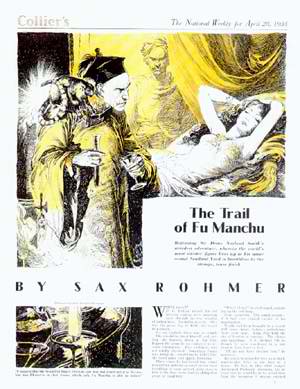
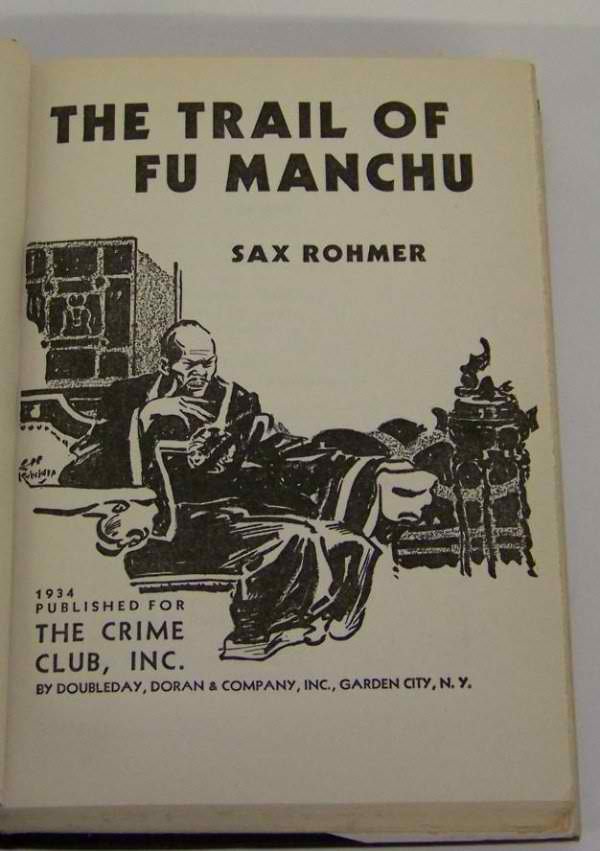 Sax Rohmer’s The Trail of Fu Manchu was originally serialized in Collier’s from April 28 to July 14, 1934. It was published in book form later that year by Cassell in the UK and Doubleday in the US. The book marked the first time Rohmer employed third person narrative in the series and dispensed with the first person narrative voice modeled on Sir Arthur Conan Doyle’s Sherlock Holmes stories. The results dilute what would otherwise have been a stronger novel that saw the series return to its roots.
Sax Rohmer’s The Trail of Fu Manchu was originally serialized in Collier’s from April 28 to July 14, 1934. It was published in book form later that year by Cassell in the UK and Doubleday in the US. The book marked the first time Rohmer employed third person narrative in the series and dispensed with the first person narrative voice modeled on Sir Arthur Conan Doyle’s Sherlock Holmes stories. The results dilute what would otherwise have been a stronger novel that saw the series return to its roots.
The book gets off to an atmospheric start on a foggy night in London, where a lone constable is standing guard outside Professor Pietro Ambroso’s art studio. He catches a glimpse of a shambling figure approaching the studio several times, but the crouching man eludes capture. A woman’s cries for help send the constable away from his post to investigate, but he finds no one. When he returns to his post, he finds the front door to Professor Ambroso’s studio open and upon investigating finds the studio deserted.
The scene shifts to Scotland Yard, where Sir Denis Nayland Smith is in conference with Chief Inspector Gallaho, who succeeded Inspector Weymouth after the latter became Police Superintendant in Cairo. The reader is somewhat surprised to learn that Professor Ambroso is also the focus of their concern. The Professor has attained fame as an artist and sculptor. His latest work is The Sleeping Venus, a stunningly beautiful porcelain nude. Ambroso had requested police protection upon his arrival in London.
Nayland Smith’s friend, the American botanist, Dr. Alan Sterling (who narrated the preceding novel in the series) recently contacted him regarding the inexplicable disappearance of his fiancée, Fleurette Petrie, while on a voyage to Egypt with her father. Sterling had seen Fleurette off when the boat disembarked and then was wired by Dr. Petrie that Fleurette had disappeared without a trace. Further complicating matters, the Italian police have reported that Professor Ambroso is presently occupying his villa at Capri.
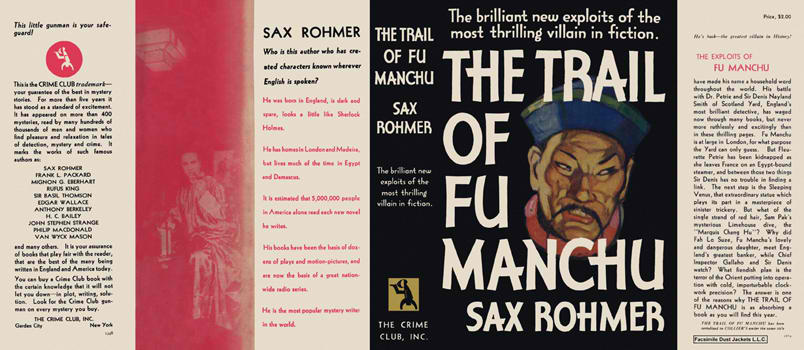
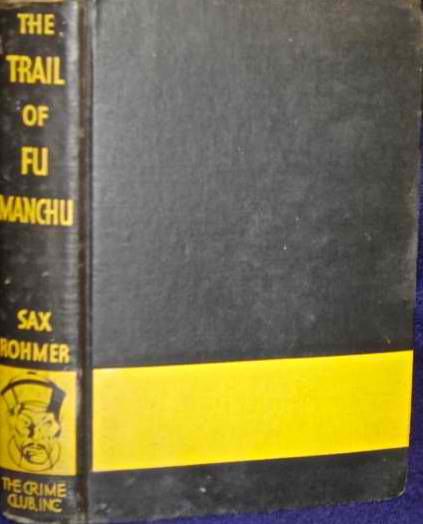 An investigation of the Professor’s London art studio confirms that The Sleeping Venus has also disappeared. Sir Denis explains to Sterling and Gallaho that he believes Dr. Fu Manchu has impersonated Professor Ambroso, arranged the abduction of Fleurette, subjected her to his catalepsy-inducing drug, and successfully disguised her as The Sleeping Venus to get her past the authorities.
An investigation of the Professor’s London art studio confirms that The Sleeping Venus has also disappeared. Sir Denis explains to Sterling and Gallaho that he believes Dr. Fu Manchu has impersonated Professor Ambroso, arranged the abduction of Fleurette, subjected her to his catalepsy-inducing drug, and successfully disguised her as The Sleeping Venus to get her past the authorities.
The daytime constable stationed outside Ambroso’s London studio informs Sir Denis that the Professor’s neighbor, Miss Isobel Demuras, had died the day before. She had moved into the house only a month earlier. She was attended by a Dr. Norton and the funeral was handled by the London Necropolis Company. Norton had bought Dr. Petrie’s practice when he moved to Cairo years before. Smith visits Dr. Norton and finds himself in the very room where he met with Petrie upon his return from Burma after escaping his first brush with Dr. Fu Manchu in a nice nostalgic reference to the series’ origins.
As Sir Denis listens to Dr. Norton’s description of his late patient, he learns that Isobel Demuras was an astonishingly beautiful Eurasian. Sir Denis surprises the doctor by asking whether she had lash marks on her back. The confirmation is enough to convince Sir Denis that Miss Demuras is really Fah lo Suee, the daughter of Fu Manchu. Smith disturbs the Secretary for Home Affairs in the middle of the night to obtain permission to exhume Isobel Demuras’s body. The bureaucrat notes that a number of ministers are questioning Sir Denis’s mental fitness because of his unsettling obsession with the Fu Manchu case.
Smith, Sterling, and Gallaho commandeer the cemetery caretaker to open the Demuras family mausoleum in the middle of the night in a scene that recalls Van Helsing and his vampire hunters’ similar action in Stoker’s Dracula. As expected, there is no body in Isobel Demuras’s tomb. The casket was weighted down with a child’s headstone that had been stolen recently. Acting on a hunch, Smith conceals himself in the mausoleum and after the others leave, he captures a dacoit who was hidden inside. Unfortunately, as the dacoit is being taken into custody by Smith and Gallaho, a knife is hurtled at him and embeds in his throat. The dacoit is killed instantly.
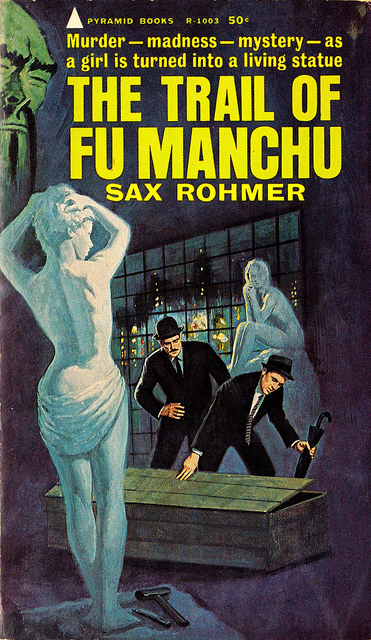
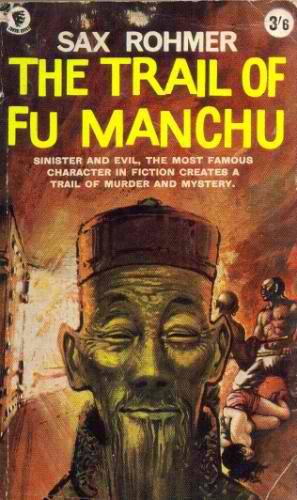 Along with Chief Inspector Gallaho, this is the first novel to introduce Sir Denis’s manservant, Fay. It is interesting that Rohmer chooses to give Sir Denis a manservant of indeterminate Eastern nationality. Earlier in the series, such a move would never have been contemplated, for such a character would have inevitably proven treacherous. By the 1930s, Rohmer seemed concerned to redress the balance even if the character still maintains a subservient role.
Along with Chief Inspector Gallaho, this is the first novel to introduce Sir Denis’s manservant, Fay. It is interesting that Rohmer chooses to give Sir Denis a manservant of indeterminate Eastern nationality. Earlier in the series, such a move would never have been contemplated, for such a character would have inevitably proven treacherous. By the 1930s, Rohmer seemed concerned to redress the balance even if the character still maintains a subservient role.
While meeting at Sir Denis’s apartment, Gallaho informs him the dacoit has been identified as a lascar who was a regular at Sam Pak’s in Limehouse. Smith suspects that Sam Pak may be John Ki, who operated an opium den in Limehouse years before and was featured in the early books in the series. One of the strengths of the book is seeing the series come full circle and return to its roots, albeit a generation later. A police raid on Sam Pak’s is prepared with Sir Denis and Sterling disguised as sailors. As the police approach the opium den, a strange blue light appears periodically over the roof as if it were a gas works.
Sir Denis and Sterling’s visit to Sam Pak’s plays like a virtual replay of the visit to John Ki’s in the first book. Once again a shapely female agent of the Si-Fan is disguised as a Chinaman. Smith spies upon the figure and discovers it is Fah lo Suee.
Retreating to the dock where they join Gallaho, they observe the queer blue light above the building. Smith recognizes it as resembling a burning ghat and believes they are watching human bodies being incinerated. This chilling scene leaves the reader with a hint of what is the most heinous of all of Fu Manchu’s crimes as we shall discover next time.
William Patrick Maynard was authorized to continue Sax Rohmer’s Fu Manchu thrillers beginning with The Terror of Fu Manchu (2009; Black Coat Press). It was followed by a sequel, The Destiny of Fu Manchu (2012; Black Coat Press). Next up is a collection of short stories featuring an original Edwardian detective, The Occult Case Book of Shankar Hardwicke and a hardboiled detective novel, Lawhead. To see additional articles by William, visit his blog at SetiSays.blogspot.com